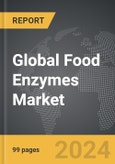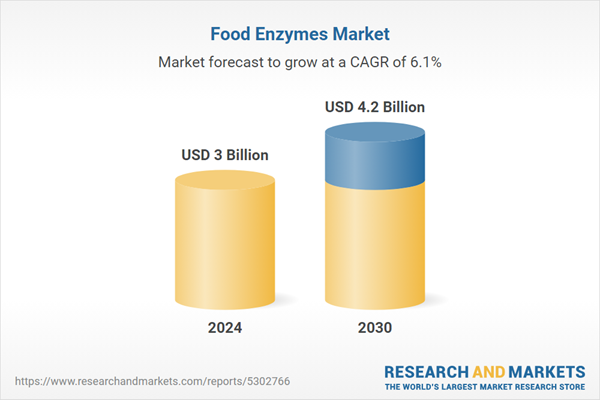Global Food Enzymes Market - Key Trends & Drivers Summarized
Why Are Food Enzymes Crucial in Modern Food Production?
Food enzymes are naturally occurring proteins that catalyze biochemical reactions in food processing, helping to break down complex molecules and improve product quality, consistency, and efficiency. Enzymes such as amylases, proteases, lipases, and pectinases are widely used in food and beverage industries, particularly in baking, dairy, brewing, and juice processing. In baking, for example, enzymes enhance dough stability, improve crumb structure, and extend shelf life by delaying staling. In dairy processing, enzymes like rennet are used to coagulate milk and produce cheese, while in brewing, enzymes break down starches into fermentable sugars to produce alcohol. Food enzymes offer numerous benefits, including faster processing times, reduced energy consumption, and improved texture, flavor, and nutritional content. Since enzymes are highly specific in their action, they provide targeted improvements in food production processes, making them essential for achieving high-quality, consistent products. As consumer demand for natural and minimally processed foods grows, food enzymes are increasingly used as natural processing aids, replacing synthetic chemicals in many applications.What Technological Advancements Are Driving the Food Enzymes Market?
Technological advancements in enzyme production and application are significantly shaping the food enzymes market. One of the major developments is the use of advanced biotechnology techniques, such as genetic engineering and fermentation, to produce enzymes more efficiently and sustainably. These methods allow manufacturers to produce enzymes at scale using microorganisms, such as bacteria and fungi, which can be engineered to produce highly specific enzymes tailored to particular food processing needs. This has resulted in more cost-effective and environmentally friendly enzyme production methods. Furthermore, innovations in enzyme formulations are enabling the development of multi-functional enzymes that can enhance multiple aspects of food production simultaneously. For instance, enzymes that improve both texture and flavor in dairy and bakery products are being introduced to streamline processing. Enzyme immobilization technology, which involves attaching enzymes to a solid support for repeated use, is also improving the efficiency and sustainability of enzyme applications. This technology helps lower production costs and minimize waste, which is crucial for large-scale food processing operations.Why Is the Demand for Food Enzymes Growing in the Clean-Label and Functional Foods Market?
The demand for food enzymes is rising sharply in the clean-label and functional foods market as consumers increasingly prefer natural, minimally processed ingredients. Enzymes offer a natural alternative to chemical additives, aligning with the clean-label trend, which emphasizes transparency and simplicity in food ingredient lists. In bakery products, for example, enzymes are used to enhance dough strength, texture, and shelf life without the need for artificial preservatives or additives. Similarly, enzymes in dairy products improve yield and texture while reducing reliance on synthetic chemicals. In functional foods, enzymes contribute to the development of products with enhanced health benefits, such as better digestion, improved nutrient absorption, and the breakdown of complex carbohydrates. For instance, lactase is commonly used to produce lactose-free dairy products, meeting the growing demand for dairy alternatives for lactose-intolerant consumers. As the market for health-conscious and clean-label foods expands, enzymes are becoming increasingly important in formulating products that meet these consumer demands while maintaining high quality and naturalness.What Are the Key Growth Drivers for the Food Enzymes Market?
The growth of the food enzymes market is driven by the rising demand for clean-label products, the increasing focus on sustainability, and the expanding market for processed foods and functional ingredients. As consumers shift toward natural and minimally processed foods, manufacturers are using enzymes as natural processing aids to reduce chemical additives and improve product quality. The clean-label movement, which prioritizes ingredient transparency, is a significant factor driving the adoption of enzymes in food production. In addition, the emphasis on sustainability and eco-friendly manufacturing practices is boosting the use of enzymes, as they help reduce energy consumption, lower production costs, and minimize waste in food processing. Enzymes are also crucial in meeting the growing demand for functional foods, particularly those that offer health benefits like improved digestion, lactose-free options, or enhanced nutrient content. With advancements in enzyme production technology, including the development of more efficient and specific enzymes, the market for food enzymes is expected to experience robust growth in the coming years.Report Scope
The report analyzes the Food Enzymes market, presented in terms of market value (US$ Thousand). The analysis covers the key segments and geographic regions outlined below.- Segments: Source (Microorganisms, Animals, Plants); Type (Carbohydrase, Lipase, Protease, Other Types); Application (Beverages, Dairy Products, Bakery Products, Other Applications).
- Geographic Regions/Countries:World; United States; Canada; Japan; China; Europe (France; Germany; Italy; United Kingdom; Spain; Russia; and Rest of Europe); Asia-Pacific (Australia; India; South Korea; and Rest of Asia-Pacific); Latin America (Argentina; Brazil; Mexico; and Rest of Latin America); Middle East (Iran; Israel; Saudi Arabia; United Arab Emirates; and Rest of Middle East); and Africa.
Key Insights:
- Market Growth: Understand the significant growth trajectory of the Microorganisms Source segment, which is expected to reach US$3.6 Billion by 2030 with a CAGR of a 6.3%. The Animals Source segment is also set to grow at 5.3% CAGR over the analysis period.
- Regional Analysis: Gain insights into the U.S. market, valued at $774.2 Million in 2024, and China, forecasted to grow at an impressive 9.1% CAGR to reach $974.3 Million by 2030. Discover growth trends in other key regions, including Japan, Canada, Germany, and the Asia-Pacific.
Why You Should Buy This Report:
- Detailed Market Analysis: Access a thorough analysis of the Global Food Enzymes Market, covering all major geographic regions and market segments.
- Competitive Insights: Get an overview of the competitive landscape, including the market presence of major players across different geographies.
- Future Trends and Drivers: Understand the key trends and drivers shaping the future of the Global Food Enzymes Market.
- Actionable Insights: Benefit from actionable insights that can help you identify new revenue opportunities and make strategic business decisions.
Key Questions Answered:
- How is the Global Food Enzymes Market expected to evolve by 2030?
- What are the main drivers and restraints affecting the market?
- Which market segments will grow the most over the forecast period?
- How will market shares for different regions and segments change by 2030?
- Who are the leading players in the market, and what are their prospects?
Report Features:
- Comprehensive Market Data: Independent analysis of annual sales and market forecasts in US$ Million from 2024 to 2030.
- In-Depth Regional Analysis: Detailed insights into key markets, including the U.S., China, Japan, Canada, Europe, Asia-Pacific, Latin America, Middle East, and Africa.
- Company Profiles: Coverage of players such as All-Q, Biobake, Brewers Clarex, Brewers Compass, Cakezyme and more.
- Complimentary Updates: Receive free report updates for one year to keep you informed of the latest market developments.
Some of the 53 companies featured in this Food Enzymes market report include:
- All-Q
- Biobake
- Brewers Clarex
- Brewers Compass
- Cakezyme
- Ha-Lactase
- Maxilact
- Novozymes Gluzyme
- Novozymes Novamyl
- Panamore
- Powerflex
- Rapidase
- Rohalase
- Rohapect
- Tolerase
- Veron Xtender
This edition integrates the latest global trade and economic shifts into comprehensive market analysis. Key updates include:
- Tariff and Trade Impact: Insights into global tariff negotiations across 180+ countries, with analysis of supply chain turbulence, sourcing disruptions, and geographic realignment. Special focus on 2025 as a pivotal year for trade tensions, including updated perspectives on the Trump-era tariffs.
- Adjusted Forecasts and Analytics: Revised global and regional market forecasts through 2030, incorporating tariff effects, economic uncertainty, and structural changes in globalization. Includes historical analysis from 2015 to 2023.
- Strategic Market Dynamics: Evaluation of revised market prospects, regional outlooks, and key economic indicators such as population and urbanization trends.
- Innovation & Technology Trends: Latest developments in product and process innovation, emerging technologies, and key industry drivers shaping the competitive landscape.
- Competitive Intelligence: Updated global market share estimates for 2025, competitive positioning of major players (Strong/Active/Niche/Trivial), and refined focus on leading global brands and core players.
- Expert Insight & Commentary: Strategic analysis from economists, trade experts, and domain specialists to contextualize market shifts and identify emerging opportunities.
Table of Contents
Companies Mentioned (Partial List)
A selection of companies mentioned in this report includes, but is not limited to:
- All-Q
- Biobake
- Brewers Clarex
- Brewers Compass
- Cakezyme
- Ha-Lactase
- Maxilact
- Novozymes Gluzyme
- Novozymes Novamyl
- Panamore
- Powerflex
- Rapidase
- Rohalase
- Rohapect
- Tolerase
- Veron Xtender
Table Information
| Report Attribute | Details |
|---|---|
| No. of Pages | 392 |
| Published | December 2025 |
| Forecast Period | 2024 - 2030 |
| Estimated Market Value ( USD | $ 3 Billion |
| Forecasted Market Value ( USD | $ 4.2 Billion |
| Compound Annual Growth Rate | 6.1% |
| Regions Covered | Global |









